The Sussex Butterfly Safari
For my 2020 butterfly safari, click here.
Welcome to my summer butterfly project for 2019. I've spent two months visiting sites in East and West Sussex, often travelling via train and my electric bike, without which some sites would be out of reach. The Knepp Estate rewilding project is a good seven miles along narrow country lanes from the railway station, but I am there in just 25 minutes. Poor weather over weeks 2 - 3 in June killed many Purple Emperors at the chrysalis stage, while dry July weather meant few visited the ground. I spent 3 days waiting and waiting, when my time could have been spent on less elusive species. Should I try the Purple Emperor again, I will pitch my tent somewhere on a wet night and search for grounded Emperors feeding on the moist surface. The challenge is that summer rainfall in the UK now falls in torrential downpours, killing numbers of the prone, tree-top dwelling Emperors.
Welcome to my summer butterfly project for 2019. I've spent two months visiting sites in East and West Sussex, often travelling via train and my electric bike, without which some sites would be out of reach. The Knepp Estate rewilding project is a good seven miles along narrow country lanes from the railway station, but I am there in just 25 minutes. Poor weather over weeks 2 - 3 in June killed many Purple Emperors at the chrysalis stage, while dry July weather meant few visited the ground. I spent 3 days waiting and waiting, when my time could have been spent on less elusive species. Should I try the Purple Emperor again, I will pitch my tent somewhere on a wet night and search for grounded Emperors feeding on the moist surface. The challenge is that summer rainfall in the UK now falls in torrential downpours, killing numbers of the prone, tree-top dwelling Emperors.
Both visitors and locals in the area surrounding the Knepp Estate are friendly. There are always people who don't want to speak (just like most people in Brighton), but it's possible to have several conversations with complete strangers in the course of one afternoon. The area is rich in wildlife, very beautiful and has a pleasant climate. I wouldn't mind living here at some point, but employment and personal responsibilities do not allow it at the moment.
Silver Washed Fritillary
The emerging evening sun prompted several of these large, woodland butterflies to come down from the tree canopy to feed on thistles and find mates. The unmated females invited male attention by posing upside down, presenting their reproductive apertures for inspection by suitors. This proved highly exciting for the males, who circled around the females, each vying to land on the thistles to court with her. Once mated, females will lay their eggs in tree bark and hatched caterpillars go straight into hibernation until the following spring. As the thistles wilted at the end of July, the fritillaries found alternative sources of nectar in the form of yellow daisies, which had seeded themselves from a nearby landscaped garden.
The emerging evening sun prompted several of these large, woodland butterflies to come down from the tree canopy to feed on thistles and find mates. The unmated females invited male attention by posing upside down, presenting their reproductive apertures for inspection by suitors. This proved highly exciting for the males, who circled around the females, each vying to land on the thistles to court with her. Once mated, females will lay their eggs in tree bark and hatched caterpillars go straight into hibernation until the following spring. As the thistles wilted at the end of July, the fritillaries found alternative sources of nectar in the form of yellow daisies, which had seeded themselves from a nearby landscaped garden.


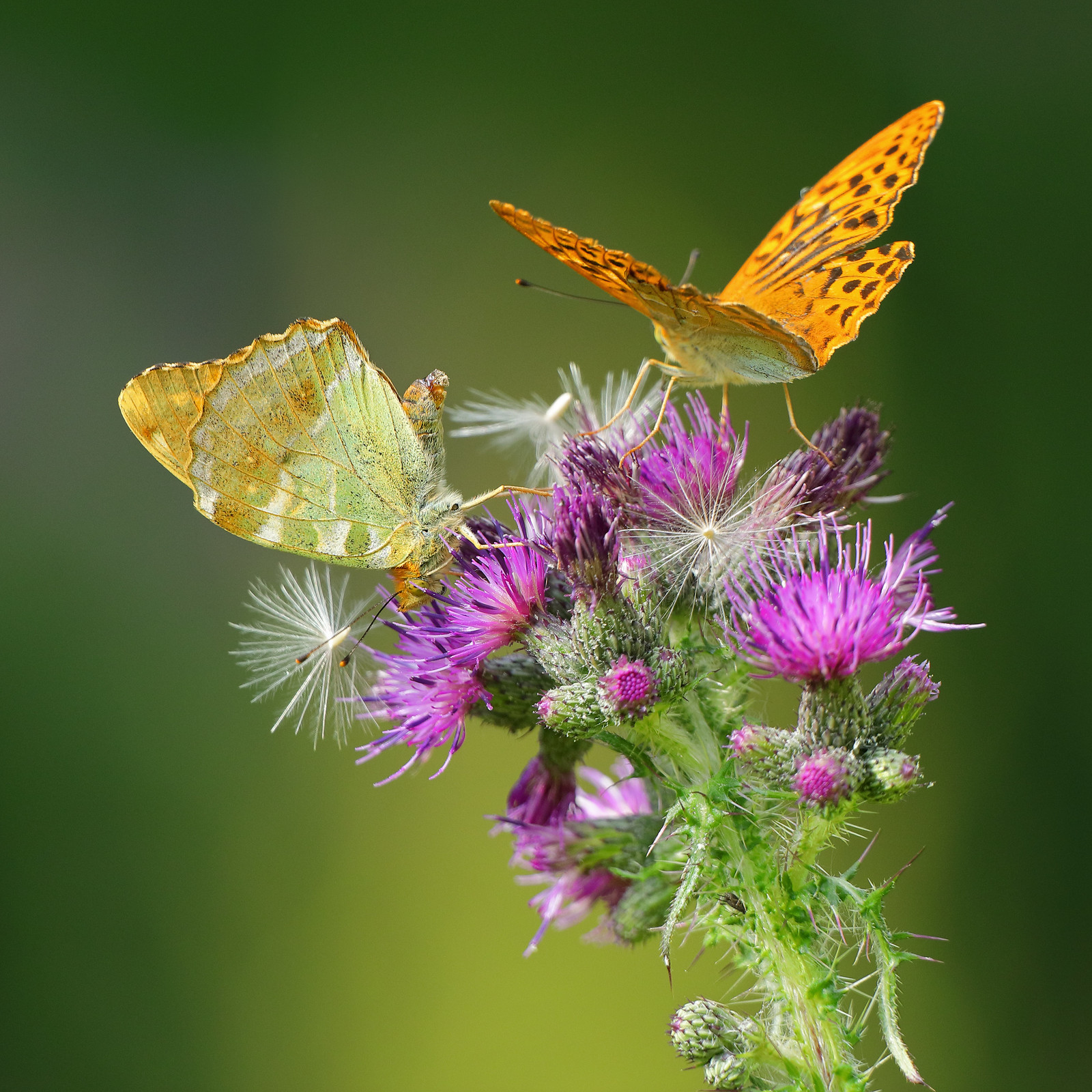
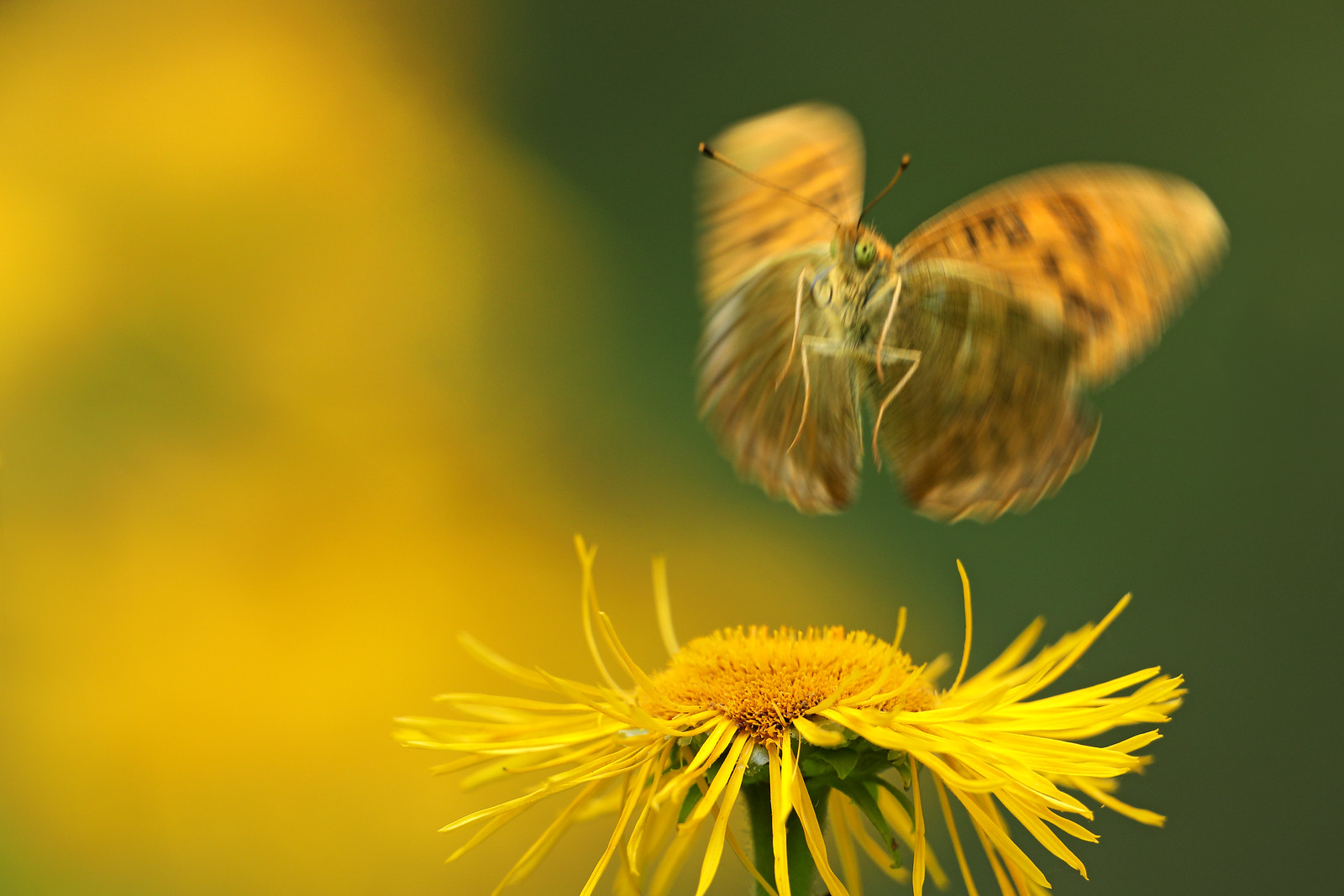
I ended my time with the Silver Washed Fritillaries, just as another heatwave began in the UK. My home city of Brighton is normally kept cooler by sea breezes and the South Downs. Just 5 years ago, typical heatwaves topped out at 29°C (inland Sussex a few degrees higher). In July 2018 and 2019 easterly winds elevated temperatures at nearby Shoreham Airport to 31°C and I would estimate the urban heat island of Brighton would be slightly higher. Even the August 2003 heatwave didn't beat this summer's figures at Shoreham Airport. Summer 2019 hasn't been particularly hot, either. While global heating produces pleasant short term side effects — sunbathing in February, English Pinot noir and warmer summers — caterpillars face threats during milder winters from diseases and pests and dry summers reduce available food. Butterflies and other animals will suffer for thousands of years because of our choices. Although the majority of CO2 from burning one tonne of coal or oil will be absorbed by oceans and vegetation after a few hundred years, 25% will still be present in 1000 years. Even 10,000 years later, 10% could still be present in the atmosphere.
White Admiral
This butterfly is a woodland species, with shade tolerance. I saw several White Admirals in Abbots Wood beating their wings, before gliding through air along a shaded path towards Honeysuckle and brambles. Nearby, is an open glade, where they settle on leaves to feed on honeydew. The topside of their wings doesn't wear well and I was much more pleased with this underside shot of the White Admiral feeding with its proboscis.

Painted Lady
This migrant butterfly is a heatwave escapee from the dangerous temperatures in France during late June 2019. Its ancestors around six generations ago began a migratory loop starting in Morocco, which will end, when this particular brood reproduces and the successive generations make their way back down to North Africa for the winter. It's thought that migration occurs because high temperatures kill off sources of nectar. As the butterfly set off from the French coast earlier in the day, it undertook an amazing high altitude journey at speeds of up to 30mph, using the distant Beachy Head and Seven Sisters cliffs as a navigational aid. The butterfly spent an hour intensely feeding on nectar, before a period of extended rest. The Painted Lady subsequently departed, to continue its migratory journey northwards, where it will reproduce somewhere in the UK. As global heating increases the frequency of heatwaves, the UK is likely to see more mass migrations of Painted Lady's in the future.

Red Admiral
Once exclusively a migrant, global heating has enabled the Red Admiral to over-winter in southern England. I observed several Red Admirals become active during the warm weather in February 2019. Unlike the Brimstone, Peacock and Small Tortoiseshell, the Red Admiral does not hibernate, but finds somewhere sheltered to rest until mild weather wakens it up. Although prematurely awoken butterflies could struggle to find sources of nectar, garden flowers in winter are becoming a more common sight on the southern English coast. Concerned householders who find butterflies awoken by central heating or mild weather should relocate them in places, where they can escape in spring.
Male Red Admirals are an excellent starter species for any photographer wishing to get into butterflies, as their behaviour in sunny weather is quite predictable. Locate a sunny woodland glade, where males are likely to be defending their territory. If the male is disturbed, it will often return to the same spot to bask. Males like the camouflage covering on my 500mm lens. They also land on my forehead or hands, to drink the sweat.
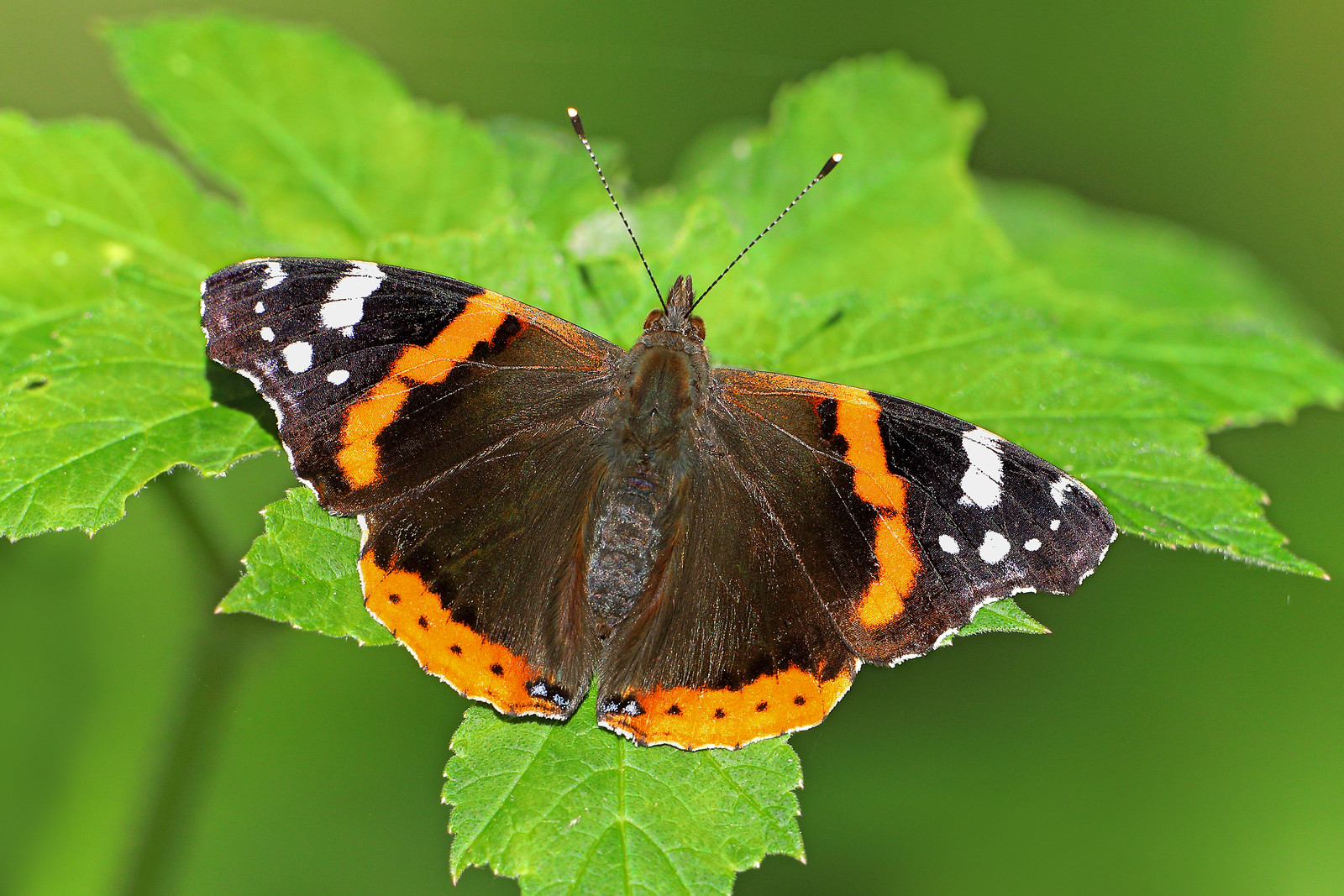

Small Tortoiseshell
I realised that the reason I hadn't seen a Small Tortoiseshell for years is that they have become less common. I was therefore delighted when two appeared at Ditchling Common car park. The moderate breeze caused my hit rate to drop, but high speed shooting gave me three good quality shots.



Peacock
My year long search for a reliable Peacock site came to an end when I discovered a large group of buddleias growing on a hillside in East Sussex. The site receives uninterrupted sunlight from late morning until dusk. At least ten Peacocks were at the site when I visited. The buddleias are densely grouped over a small area and there are no competitor food plants nearby, which means the butterflies remain in situ.
I returned to the site on 25th July to observe how the Peacock behaves in high temperatures. As predicted, they were lethargic and protected their bodies from over-heating by not opening their wings. The afternoon was around 60% humidity, intermittently cloudy with temperatures in the low thirties. I heard thunder in the distance and rain fell briefly. Direct sun, still air, 35°C and 18% humidity in Madrid is easier to bear than the same conditions and 50% humidity in East Sussex, due to a Humidex of 45°C. No wonder I began feeling nauseous, cold and clammy. When the sky cleared at 5pm, temperatures soared to 35°C and all resting Peacocks immediately left for the shade and refused to re-emerge. Cambridge University Botanic Garden broke the UK record, with 38.7°C and the temperature could have reached 40°C, but cloud cover later in the day prevented it. Should heatwaves become more frequent, butterfly broods will occur earlier in the summer, although broods may run into problems due the inherent unpredictability of our climate.

I returned to the site on 25th July to observe how the Peacock behaves in high temperatures. As predicted, they were lethargic and protected their bodies from over-heating by not opening their wings. The afternoon was around 60% humidity, intermittently cloudy with temperatures in the low thirties. I heard thunder in the distance and rain fell briefly. Direct sun, still air, 35°C and 18% humidity in Madrid is easier to bear than the same conditions and 50% humidity in East Sussex, due to a Humidex of 45°C. No wonder I began feeling nauseous, cold and clammy. When the sky cleared at 5pm, temperatures soared to 35°C and all resting Peacocks immediately left for the shade and refused to re-emerge. Cambridge University Botanic Garden broke the UK record, with 38.7°C and the temperature could have reached 40°C, but cloud cover later in the day prevented it. Should heatwaves become more frequent, butterfly broods will occur earlier in the summer, although broods may run into problems due the inherent unpredictability of our climate.

Comma
The Comma is one of our longest-living butterflies, overwintering in hibernation by disguising itself among leaves. It is one of the first butterflies to be seen on mild winter days, basking in sunshine, much as it does in the summer months. The species was in decline, but has staged a dramatic recovery. I photographed this specimen and others at the Knepp Estate, once I had given up with the Purple Emperor and its tree-top camaraderie.
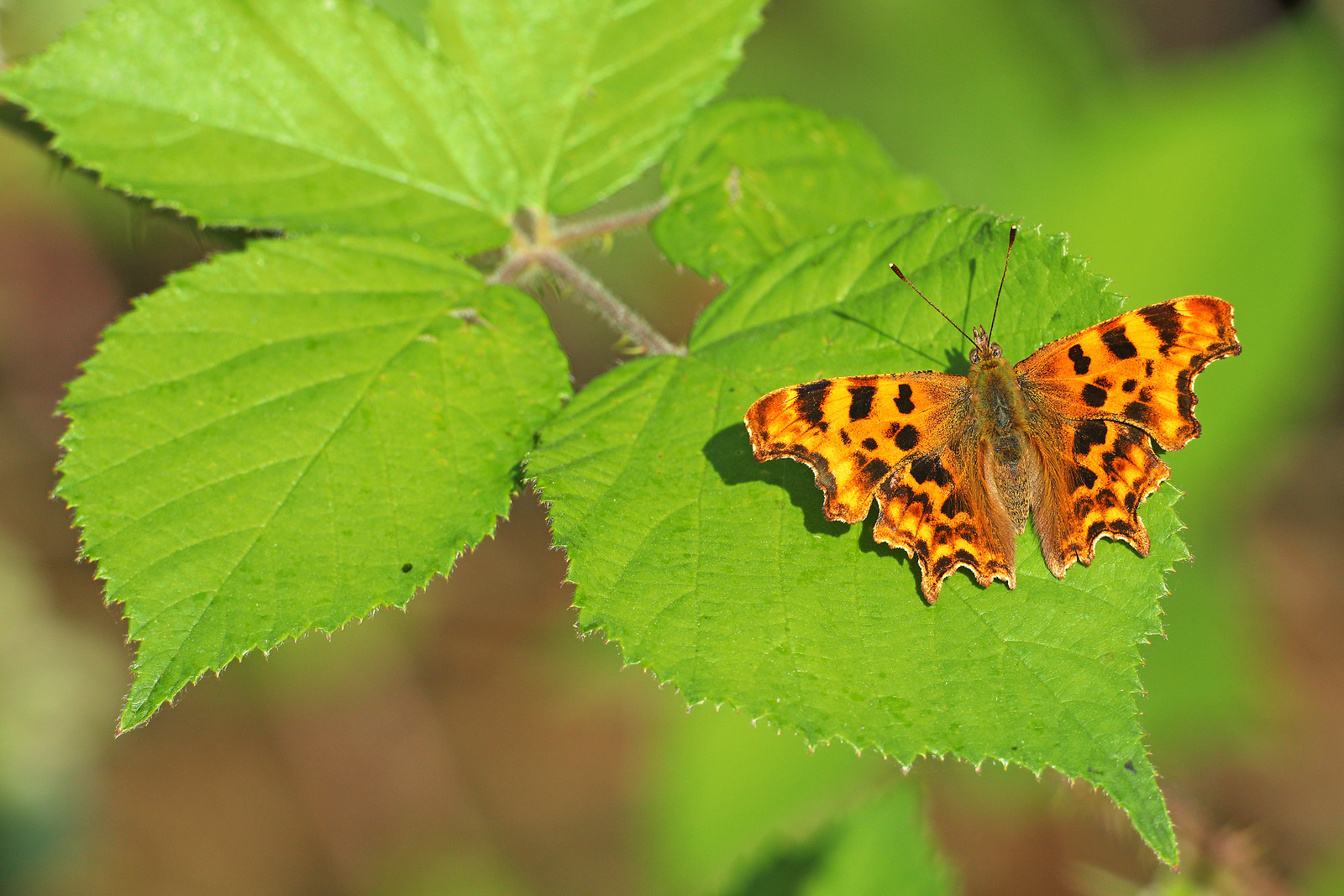
Gatekeeper
This species is similar to the Meadow Brown, but unlike the latter, it basks on the ground with open wings for long periods. The Gatekeeper is the opposite of the Purple Emperor, which is the only UK butterfly with a pronounced Judy Garland Complex. This Tragedy Queen of a butterfly stubbornly refuses to come to the ground unless there is dog faeces, instead preferring to squabble with one another, launch Kamikaze attacks on Crows or assist females out of the chrysalis so they can mate them with immediately. No wonder they are all dead within weeks. The Gatekeeper is a quiet, gentle soul and I caught this fresh specimen basking in the Sallows at Knepp. The second shot was taken at a very popular brambles on the path down to Cuckmere Haven.


Small Copper
The Small Copper is another gentle soul. The species is widespread, but occurs at fairly low densities. This specimen is feeding on the same brambles as the Gatekeeper, which additionally attracted Meadow Browns, Marbled Whites, Red Admirals and the Painted Lady. The site featured the second most number of trite comments from passers-by about the size of my camera/lens. After an old buffoon scared off a resting Purple Hairstreak in West Sussex, I've started telling people that it's the smallest camera I could afford, while mentally admitting them into the nearest A&E.

Meadow Brown
The 'boring' Meadow Brown is one of our hardest species to photograph. The slightest noise, even from a good distance, will send all nearby Meadow Browns, which numbered in the hundreds at this site, into a flurry of wings. They become completely preoccupied when nectaring. I was lucky to find this fresh specimen in a West Sussex wood.
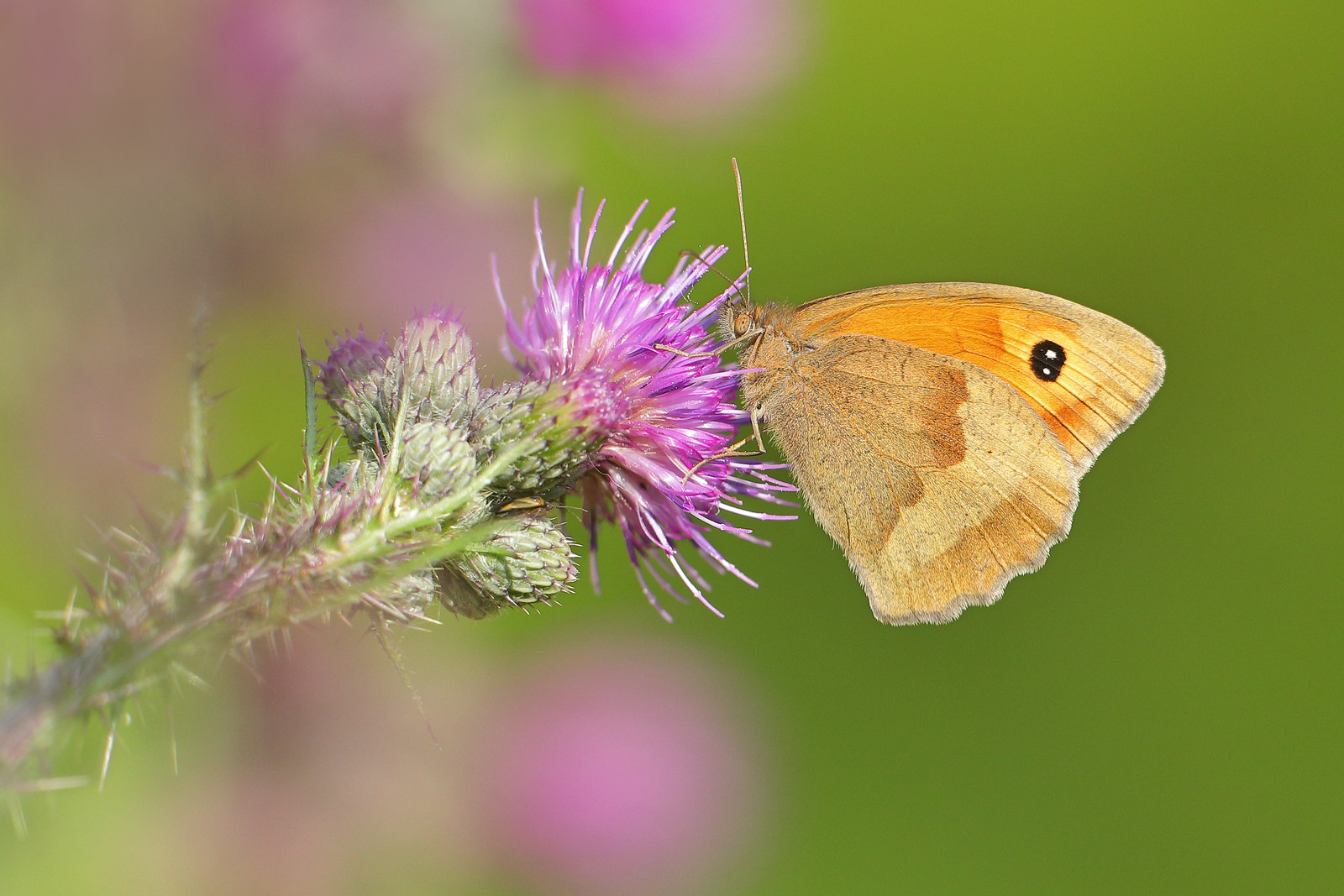
Chalk Hill Blue
In sunny weather, the Chalk Hill Blue likes to bask open-winged. It can be difficult to get an extreme close-up of this species, as the shadow created by the photographer makes the butterfly dart off. The only suitable opportunity for extreme close-ups comes during hot weather, when the sun disappears for a few minutes. The butterfly will still have its wings open, but the lack of sun means the photographer will not cast an alarming shadow. Since hot, interchangeably sunny and sunless weather is not (yet) common in the UK, I find it best to photograph open-winged Chalk Hill Blues using a 500mm lens and three stacked extension tubes. Using a high resolution DSLR, I can still get crops of between 11 and 18 megapixels, while maintaining a 2 metre distance.
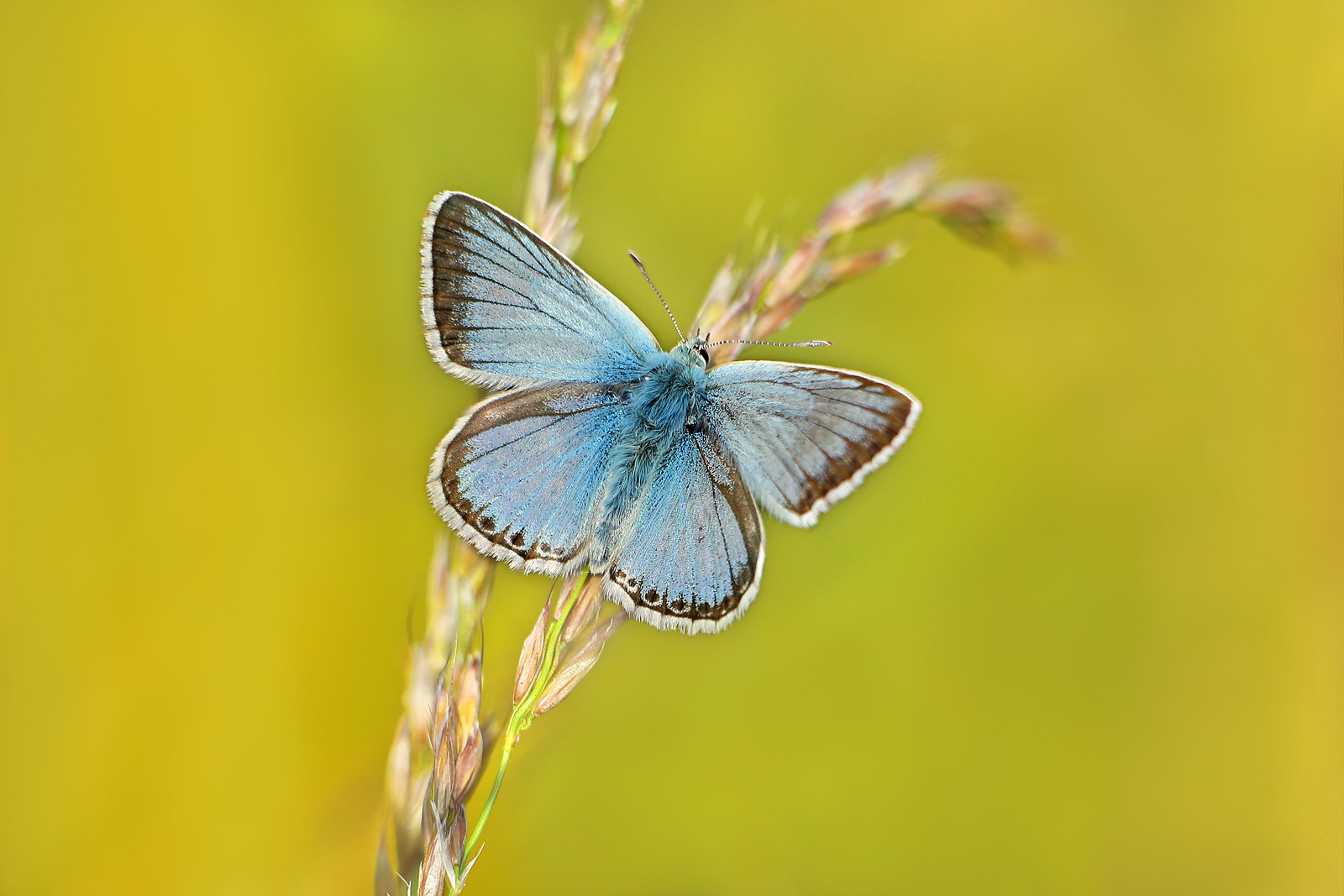


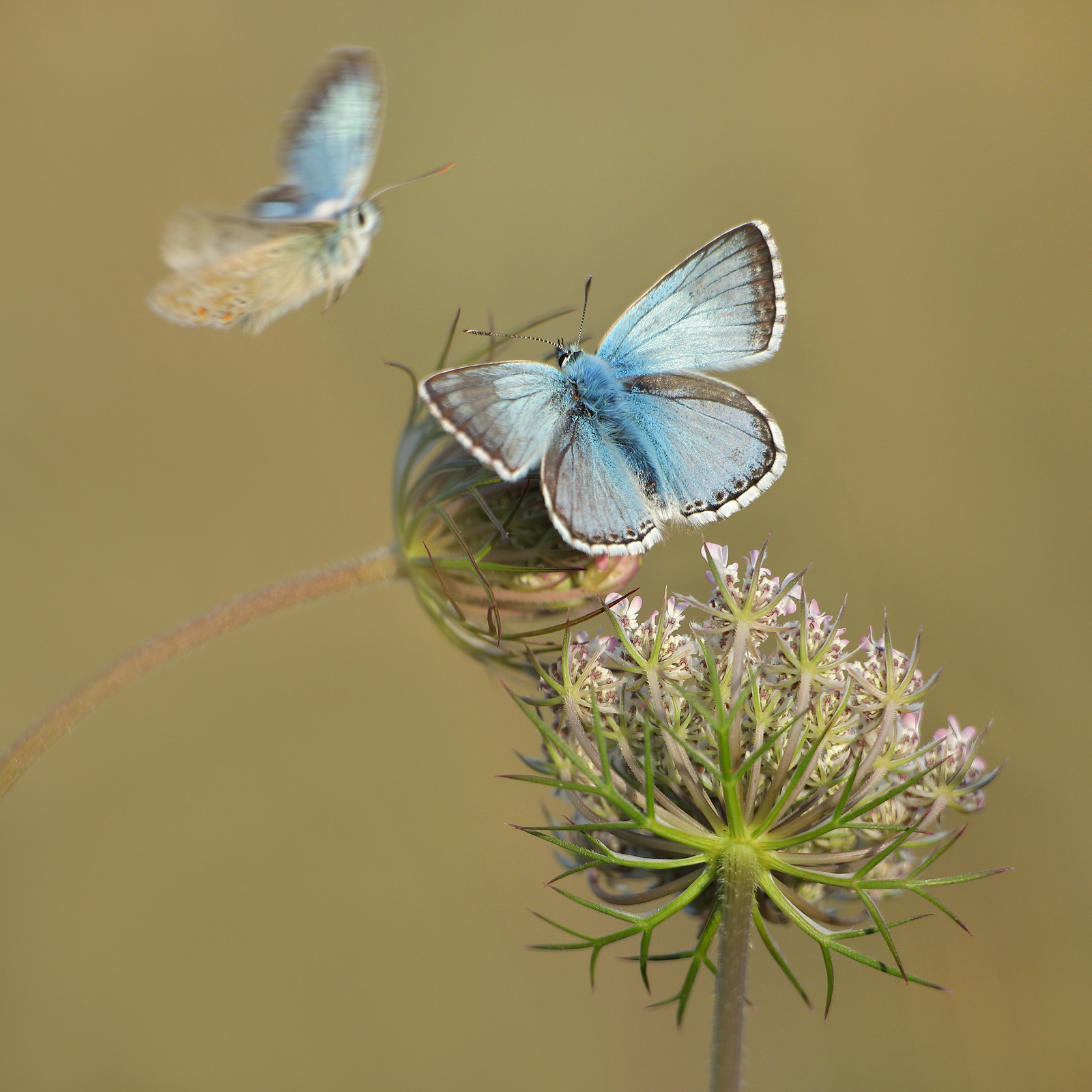



Other Wildlife
My butterfly sites are healthy, thriving ecosystems, which support diverse lifeforms from soil bacteria and underground fungi to numerous mammal and bird species. I was delighted to spend time with a Broad-bodied Chaser dragonfly, observe three Red deer cavorting in mud and chasing each other around a lake. Knepp is a good place to watch grey squirrels, especially when the estate is drenched in golden crepuscular sunbeams. One of my other sites, discovered last year, is a reliable site for butterflies and Roe deer. Just don't ask where it is or attempt to find it.
My butterfly sites are healthy, thriving ecosystems, which support diverse lifeforms from soil bacteria and underground fungi to numerous mammal and bird species. I was delighted to spend time with a Broad-bodied Chaser dragonfly, observe three Red deer cavorting in mud and chasing each other around a lake. Knepp is a good place to watch grey squirrels, especially when the estate is drenched in golden crepuscular sunbeams. One of my other sites, discovered last year, is a reliable site for butterflies and Roe deer. Just don't ask where it is or attempt to find it.

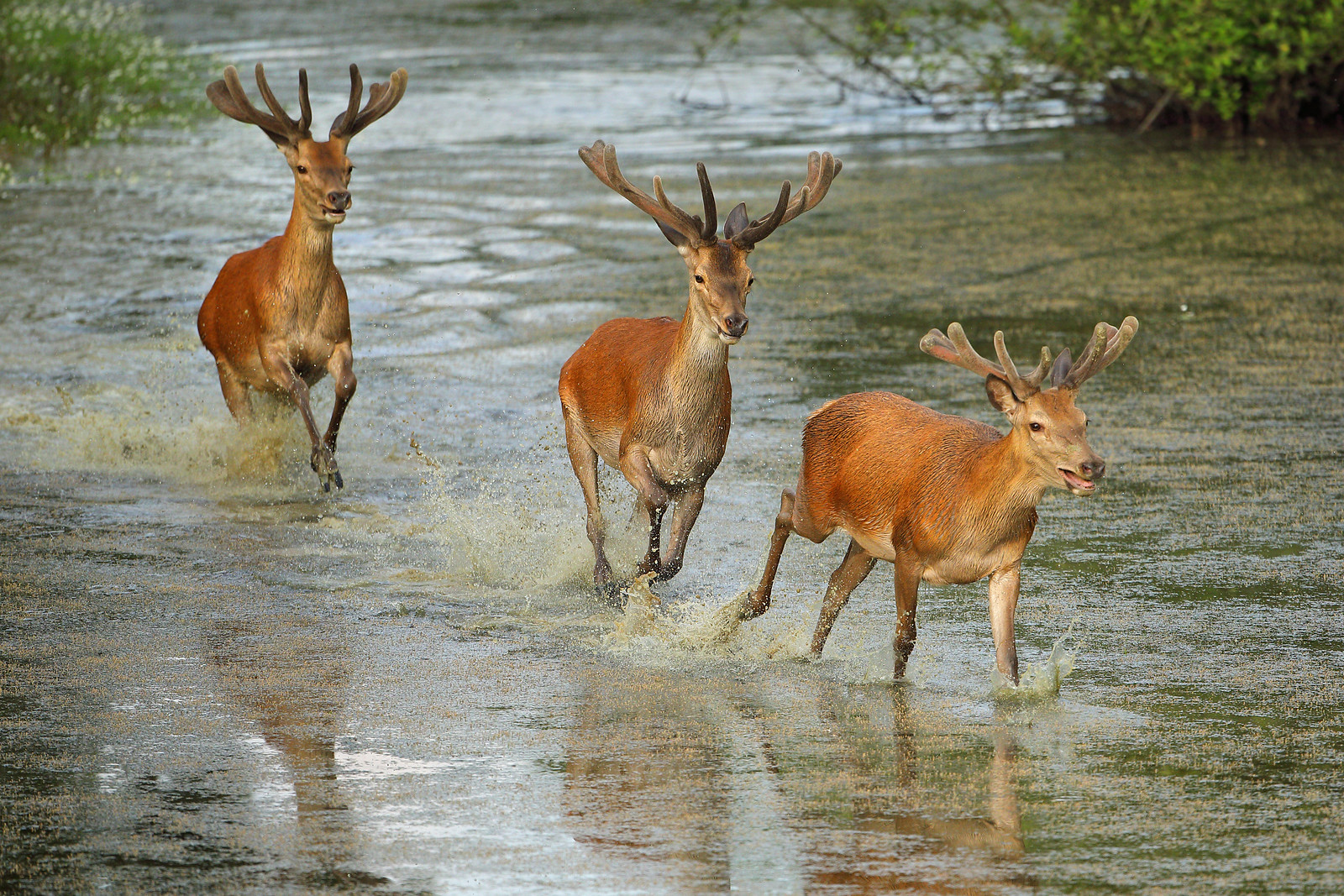
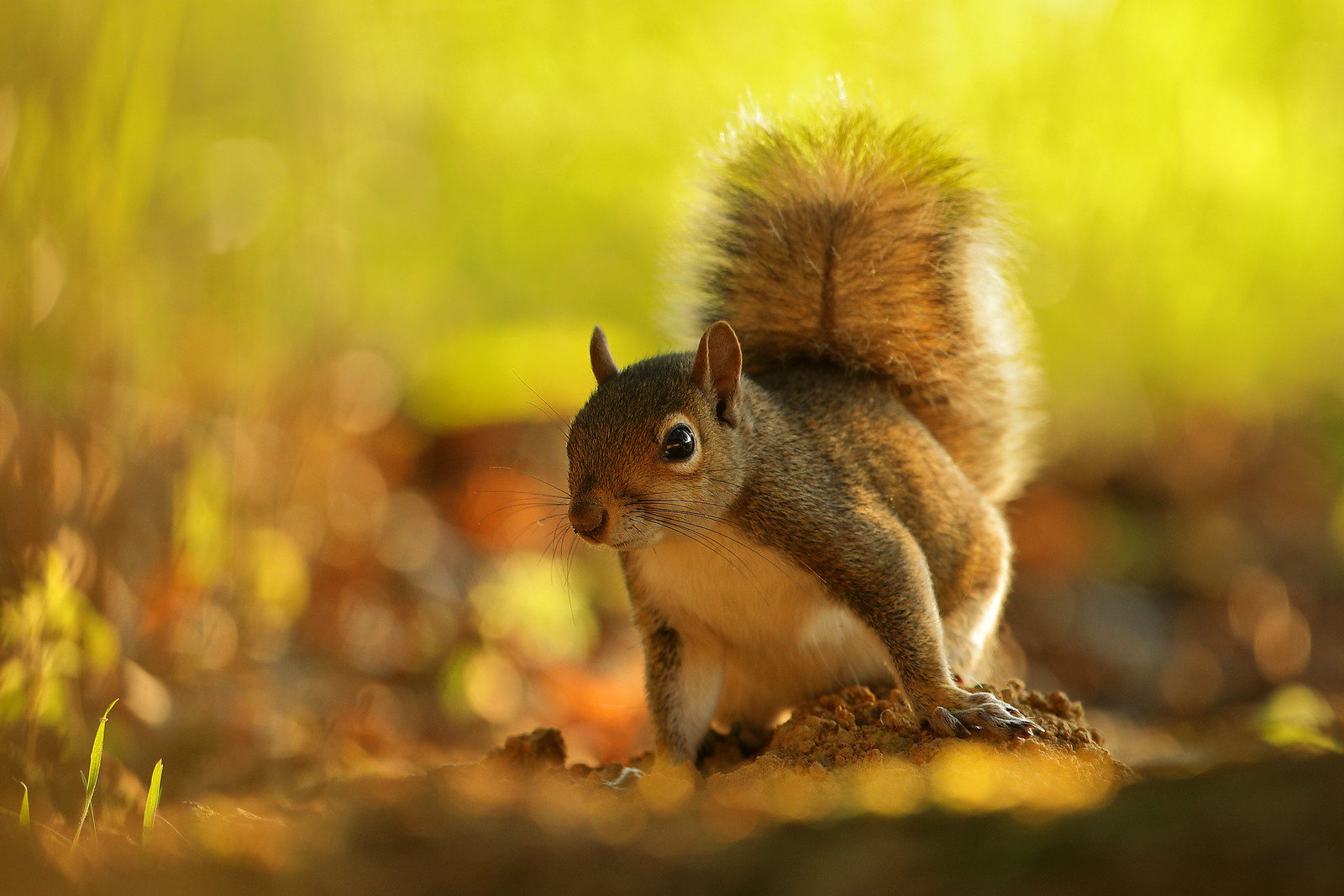

Tips for photographing butterflies well:
1. Find a location where food plants are densely grouped over a small area and lit by the sun for at least a few hours.
This will ensure that local species will congregate within photographic
distance and not stray, allowing multiple opportunities to get high
quality shots. The Knepp Estate has food plants scattered over a very
wide area, meaning a particular food source may not be visited often due
to the huge choice of nectaring sites. Abbots Wood, in contrast, has a
glade attracting White Admirals, Silver Washed Fritillaries and Painted
Lady's to the Honeysuckle and Brambles, because the surrounding flora is
simply dense woodland.
2. When a butterfly lands and opens its wings, wait for the proboscis to begin feeding nectar or salts before approaching.
Butterflies provide the best opportunities for photography when they
are preoccupied with food sources. Approach too soon and the butterfly
will depart.
3. Use a telephoto lens, extension tubes and a high resolution DSLR.
Unless they are immobilised by cool temperatures, butterflies really
don't like it when someone tries to photograph them using a 100mm lens
from 30cm. 'Silent' autofocus startles them, as does mirror return and
clicking. My hit rate increased when I started pairing my 500mm lens
with three extension tubes, allowing sharp focus at 2 metres. The confidence of a high success rate allows me to become choosy, photographing only the most pristine
butterflies and not settling for worn specimens because that's all I
can get. If the butterfly is moving about, I will shoot at 7
frames-per-second and AI Servo, stopping down between f/5.6 - f/9.0 and
setting the ISO speed between 400 - 800. I always use a gimbal head and
tripod. I've seen people hand-holding short macro lenses and shooting at
ISO 2000, which is fine if all you want is distant 2.3 megapixel record
shots, but my technique gives me sharp, high quality images with a
beautiful bokeh at crop resolutions of 12 - 21 megapixels.
4. Time visits to photograph fresh wings. The condition of butterflies will affect the final quality of your images, so it's important to become familiar with how weather can influence the emergence of adults. As
a rule, warm temperatures will bring them out early in the season, but a cool start
to the summer can delay some species for a few weeks. It is also worth
noting that a sunny morning, which turns cloudy can bring down the
Purple Hairstreak and keep them inactive on ferns, while they wait for
the sun to come out again. The Purple Emperor, which seldom comes to the
ground, may do so on the morning after rain, as moisture releases salts
from the surface. During a warm, dry month, such as July 2019, it may
not be worth waiting to see grounded Purple Emperors at all.
big butterfly count
big butterfly count
Comments
This is a great photographic essay. I applaud all the time, effort and thought you would have needed to invest in the process, in order to have created this piece.
I learnt a lot of very interesting information and will now have a greater appreciation of butterflies when I'm with the deer.
Thanks again,
Mark
I'm glad you enjoyed my photo essay and thank you so much for your comment! Butterfly populations in the UK have been in decline, both in range and numbers since 1976. The fact that I had to expend a lot of energy in finding reliable sites indicates habitats are becoming rarer. Once very common species, such as the Gatekeeper and Small Tortoiseshell are dwindling.
I haven't quite finished with the butterflies, as I'm expecting to see a large number of Painted Ladies and I'd like to revisit the Peacock site with the buddleia. I will update this page before the summer ends.
I read your excellent guide to photographing Roe deer. Great work, Mark.
Alan.
Glad you liked the deer article.
What's happening to butterfly numbers and their distribution is very concerning. We need to right people to listen and act on everything nature is telling us.
I hope the rest of your butterfly project goes well and look forward to the update on this page.
All the best,
Mark
I'm off to one of my butterfly sites today, for the Painted Lady and Peacock. The moderate SW breeze is concerning, though.